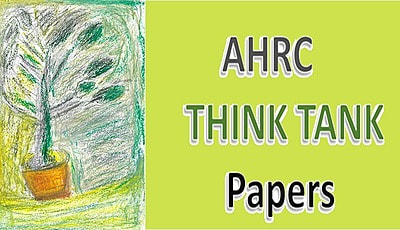Corruption and counter corruption across Asia
Editorial board, article2
The problem of corruption is rampant in many Asian countries. It seriously affects all aspects of people’s lives, as almost nothing can be done without giving bribes. If you want to make a complaint to the police or any authorities, you have to give bribes. If you want to get a driving licence or open a shop, you have to give bribes. If you want to receive a public service, such as education and healthcare, you have to give bribes. If you want to be properly treated in police custody, you have to give bribes. Even if you want to make a petition to court concerning all these problems, you have to give bribes. All the public institutions, which are supposed to provide services and protection to safeguard the human rights of people, have become dysfunctional because of corruption. In this sense, corruption is a main obstacle for the protection and promotion of human rights, as it destroys the proper functioning of the public institutions.
Corruption is the enemy of the rule of law. Under corruption, there is no respect for laws, because laws cannot be enforced or they are enforced arbitrarily in favour of people who have power or can afford to pay bribes. The key institutions for the rule of law–the police, the prosecution and the judiciary–become dysfunctional. As a result, people have no means to make complaints or seek remedies. It is a total denial of justice.
To tackle the problem of corruption, the Asian Legal Resource Centre held a Regional Consultation on Anti-Corruption Mechanisms in Asia, in Hong Kong on 11-15 January 2010. The aims of the consultation were to develop knowledge and critique existing mechanisms for the elimination of corruption in Asia and to introduce the participants to the Independent Commission Against Corruption (ICAC) in Hong Kong, so as to provide opportunities for comparative studies on corruption control.
Fifteen participants from nine countries (Bangladesh, Cambodia, India, Indonesia, Nepal, Pakistan, South Korea, Sri Lanka and Thailand) took part the consultation. The participants included the commissioners of anti-corruption commissions, activists of anti-corruption NGOs, human rights lawyers and scholars.
During the consultation, participants presented the situation of corruption and the functioning of anti-corruption mechanisms in their countries, exchanging experience and ideas on how to enhance the development of effective anti-corruption mechanisms. The participants also spent a day to visit the ICAC to learn about its successful experience in fighting corruption.
The papers of participants for the consultation constitute this issue of article 2 (vol. 9, no. 1, March 2010). They provide an in depth picture and wide range of experience in fighting corruption in these Asian countries. The common concerns and principles in tackling the problem of corruption raised by the participants are contained in the statement of the consultation, which opens the issue.
The edition follows with a paper on Sri Lanka that focuses on the problems with the appointment, mandates and powers of the Bribery and Corruption Commission in the political context of the non-functioning of the Constitutional Council. For some years, the president has appointed the commissioners without checks and balances. Other attendant problems are the extreme politicization of the commission and its activities, the disallowance of the commission to investigate complaints on its own initiative and the lack of an independent investigative force as possessed by the anti-corruption body in Hong Kong.
The experience in Indonesia provides a very valuable lesson for other Asian countries on how to develop effective anticorruption mechanisms with the support of the public. The two papers on Indonesia, one by an anti-corruption commissioner and another by an anti-corruption activist, together give a comprehensive picture of the development of the Corruption Eradication Commission (KPK), the selection process of its commissioners, its powers and functions, what has been achieved and the present challenges. In his paper, KPK Commissioner Mochammad Jasin emphasizes that the KPK has accompanied law-enforcement efforts with prevention, supervision and coordination of all law enforcement institutions involved in processing corruption cases, and has at all points sought the participation of the public. The KPK is an independent body with a wide range of powers in investigation. The second paper discusses the advantage of the KPK of its support from civil society, the media and the public. However, it underscores that the political environment is still difficult, with the police fighting back and lack of support from political elites. The KPK also needs to develop its own investigative force instead of depending on the police to conduct investigations.
The paper on Pakistan highlights the key areas of corruption and problems of anti-corruption arrangements there, tracing corruption in land grabbing and allocation of state resources that have been institutionalized to provide benefits to the powerful sectors in which military personnel are dominant. The most important implication of this institutionalized corruption is that powerful actors–whether they are state or non-state–cannot be brought under the anti-corruption laws extant in Pakistan. The military, judiciary and lately the Islamic clergy are all by law outside the authority of anti-corruption mechanisms. The paper suggests the creation of a constitutional body to oversee all aspects of corruption and to include all groups, the strengthening of capacity and functions of the auditor’s office, and bureaucratic reform as some possible solutions.
The paper on Thailand discusses the role of civic organizations in fighting corruption through education, monitoring and watchdog functions. It illustrates four successful cases to show how civic organizations fight corruption. As corruption is still prevalent, Thailand needs to strengthen both state institutions in charge of fighting corruption from the top, as well as to multiply and strengthen civic corruption watchdogs that can chase and catch corruption at the bottom.
As described in the next paper, corruption in Bangladesh is so deeply rooted and institutionalized that it has become the way of life. The paper concentrates on the problems of corruption in the judiciary, describing the methods associated with corruption, from jumping the queue of cases to be heard on a given day to getting a copy of the judgment. The paper emphasizes that people should be willing to eliminate corruption and suggests some steps towards this end.
Corruption in Cambodia is still rampant. The paper on this country gives an overview of the existing laws and legal mechanisms for counter-corruption activities and assesses the prospects for development of anti-corruption mechanisms. The government has approved a draft anti-corruption law, but its contents have not been disclosed and the law is now waiting to be passed through the National Assembly. The lack of seriousness and political will to fight corruption is the key problem. The paper suggests several ways in which assistance could be given to promote anti-corruption work in Cambodia.
Instead of describing practices of corruption directly, the paper on India describes how people have been deprived of their livelihood through programmes for access to food and work due to the corruption patronized by the state. The state adopts growth based development policies and squeezes public resources to provide benefits to the private and corporate sectors, whereas the poor and the marginalized are denied basic rights. Unaccountability has been fostered in a manner to further enhance corruption. Protections enshrined in the constitution and laws are not respected and ensured for people in need, as most public resources are sacrificed to corruption.
All in all, the edition paints a bleak picture of the situation in most parts of Asia, but also gives some cause for hope that more and more people are determined to effect some kind of lasting change to the cultures of corruption that have eaten into countries across the region for so long. Although there are no short-term or easy solutions, the fact that people like those who assembled in Hong Kong for this consultation are thinking seriously through their problems, articulating them and looking for ways ahead in itself raises the possibility of a future for the region that will be markedly different from its past.



